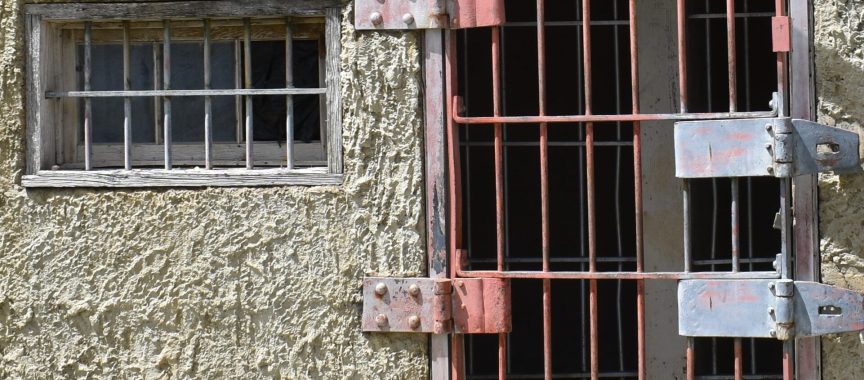News – Sheridan Media

In 1888, the new county of Sheridan decided that it needed a jail. It was located at Burkitt and Whitney on the southwest corner of the lot.
The town had already purchased two steel jail cells, so the dimensions of the newly built jail had to accommodate these cells.
The first few bids were rejected, as we see in this story in The Enterprise, June 16, 1888 – The full board of county commissioners were in session yesterday. No business of importance was transacted. There were a number of bids for the construction of a jail, but owing to the fact that the specifications called for cells too small for the steel cages they were all rejected. New plans will be drawn up at once and bids advertised for.
A few months later, we find that a bid was accepted for the jail. The Enterprise, September 8, 1888 – In regard to the bids for the construction of a building to be used as a county jail, it appearing to the board that the proposal of Geo. Brundage was the lowest, on motion the contract was awarded to said Geo. Brundage for $1,387. (This is equivalent to $46,149.71 in today’s money.)
On motion the following tax levy was made for the year 1888: (Interesting to see where the money was used in 1888)
Territorial general fund – 21/2 mills; Capitol building 2 ¼; University income tax ½; Territorial bond, 6-10; Insane Asylum – 1-10; Stock Indemnity fund 1-100; County general fund -5; School tax, 2; Special jail tax, 2; Roads and Bridges- 2; County Poor and Pauper- 2.
A special school tax of 3 mills was levied on each district except Nos. 5 and 8, No. 5 is 1-10; in No. 8 is 8-10.
A special road tax of $3 on each able bodied man between the ages of 21 and 50 years was levied.
Geo. Brundage appeared before the board and signed the Contract for the building of the county jail and gave bond in the sum of $2774 for the faithful performance of the conditions, etc, Board approved bond and ordered same filed. The bond and oath of office of John A. Collins as constable of Sheridan precinct was presented. On motion board approved said bond and ordered same filed.
The jail was finished a few months later.

The Enterprise, December 1, 1888
The jail met with the approval of the Sheridan Grand Jury. This from The Enterprise, September 20, 1890 –Report of the Grand Jury. September 16. 1890, Report of the grand jury for the 2nd judicial district, Sheridan county. Wyo.: We, the grand jury, take pleasure in making the following as our report: We have examined into and disposed of all cases brought to our knowledge affecting the welfare of the county. In an examination of the county jail we found it to be a good, substantial and safe building except as to the condition of there of the roof.
It is well kept, but we recommend that the drainage pipes be defended and covered sufficiently to prevent freezing, and that a cesspool be made into which such pipes should empty. We would recommend that the roof of the jail be supported in the center or otherwise supported to prevent springing. We are pleased to find no occupants in the jail and were informed there has been none for a long time. – John M. Calloway, Foreman

On Display at Jim Gatchell Memorial Museum, Buffalo, Wyo
Obviously, there was not much crime in the area. In 1890 there were around 2000 people in Sheridan County, most of which lived in the town of Sheridan.
The first Sheriff to oversee the jail in Sheridan was James M. Enochs. In this story we find him pursuing horse thieves in the Sheridan area. The Sheridan Post, September 19, 1889. – Mexican Horse Thieves – Some time ago A.N. Cantley left Southern Colorado with a band of horses intending to locate them in Northern Wyoming. He and a young Mexican with him on starting and afterwards an older Mexican, some 35 or 40 years of age, fell in with them and accompanied them to Powder River near the LX bar ranch where they stopped.
Mr. Cantley went out to look for a good winter location, leaving the two Mexicans in charge of the camp and horses. When he returned Sept.10th he found the camp deserted and about 20 head or his horses missing. In company with others Mr. Cantley set out in pursuit and striking the trail followed it into the hills on Badger and Dutch creeks where they lost it. Sheriff Enochs having heard of the theft was on the alert and when the younger Mexican came into town last Saturday morning for supplies arrested him and lodged him in jail. Upon being questioned he gave the whole matter away and told the sheriff where he would hide the horses and the other Mexican in the Cat Creek hills.
Sheriff Enochs, accompanied by Deputy Gross, immediately set out in search and found the horses and the thief, but the Mexican instead of giving up, as requested, cocked his rifle and put spurs to his horse. The sheriff and his deputy opened fire, after dismounting from their horses, but were unable to bring down neither the Mexican or his horse. In the mean time the officers’ horses had joined the herd and were fleeing over the hills, so all that was left for the officers was to return to town on foot.
On the following day a party started out in pursuit. Enochs and Gross recovered the horse the Mexican had ridden, which he had abandoned. The horse was wounded m the neck and there was a bullet hole through the cantle of the saddle and that with the bloody tracks indicated that the Mexican had been severely wounded, but at this writing no trace of him has been found. The stolen horses have all been recovered.
Mr. Cantley, their owner, was a Colorado deputy sheriff a couple of years ago and was the first officer to attempt the arrest of that noted desperado Newt. Vorce. He killed both the horses Vorce was driving but received three shots himself from the effects of which he still suffers, but the desperado escaped to be captured afterwards, several persons having lost their lives before he was taken into custody and finally lodged in the penitentiary for 15 years.

Old Frontier Prison, Laramie, Wyo
This jail building served as the Sheridan County jail for approximately 24 years. Over time it became seriously antiquated and deficient by the time it was replaced in 1913.
The Sheridan Enterprise, November 25, 1912 – Serves Notice on the Commissioners – County Attorney Gogerty advising them to readopt plans and specifications for a the projected $35,000 jail building and sheriff’s quarters and to re-advertise for bids…. The county attorney takes the stand that in accepting plans of the Pauly company of St. Louis, the board has shut out all competition. Should the board fall to comply with the request of the county attorney and award the contract on December 3, as advertised, and injunction will be served on them, restraining them from carry the contract into execution….
The adoption of these plans and the devices of the Pauly Jail company, to the exclusion of ail other jail furnishes, means practically that you have purchased the jail equipment of this company without advertising for bids thereon and without ascertaining comparative cost and comparative efficiency of different jail equipment….
I appreciate the need of a new jail building but I do not deem the need so urgent as to warrant undue haste, the lack of competitive bidding and a disregard of legal limitations. I urge you to to rescind the adoption of the Pauly Jail company’s plans, specifications and devices and to reject all bids for the construction of this work and to postpone further action on the matter. – D.L. Gogerty County Attorney
In March, 1913, the contract was awarded to Pauly Jail Building Company.

The Sheridan Post, March 7, 1913
Today, Sheridan has a modern Sheriff’s office, police force and jail to house those who take it upon themselves to inflict harm on law-abiding citizens.
But, 137 years ago this month, Sheridan began construction on the first jail for the newly organized Sheridan County.
Last modified: September 15, 2025






